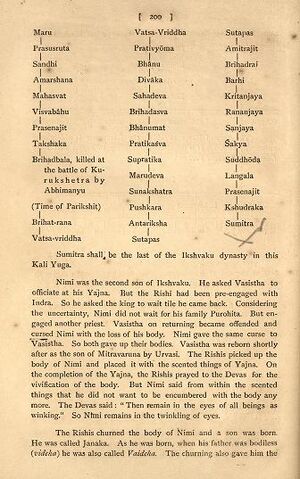Maru
Maru (मरु) Maroo (मारू)[1] is a Jat Gotra found in Haryana and Rajasthan and Pakistan. Maru clan is also found in Afghanistan. [2]
Contents
Variants
Jat Gotras Namesake
- Maru = Marohæ (Pliny.vi.23)
Mention by Pliny
Pliny[3] mentions 'The Indus.'....Below these deserts are the Dari and the Surve, and then deserts again for one hundred and eighty-seven miles, sands in general encircling these spots just as islands are surrounded by the sea. Below these deserts, again, are the Maltecoræ, the Singæ, the Marohæ, the Rarungæ, and the Morontes. These last peoples, who possess the mountains throughout the whole range of country as far as the shores of the ocean, are free, and independent of all kings, and hold numerous cities upon the declivities of the mountains.
Jat clans mentioned by Megasthenes
Megasthenes also described India's caste system and a number of clans out of these some have been identified with Jat clans by the Jat historians. Megasthenes has mentioned a large number of Jat clans. It seems that the Greeks added 'i' to names which had an 'i' ending. Identified probable Jat clans have been provided with active link within brackets. (See Jat clans mentioned by Megasthenes)
| Jat clans as described by Megasthenes | ||||||||||||
| Location | Jat clans | Information | ||||||||||
|---|---|---|---|---|---|---|---|---|---|---|---|---|
| 10. Below the deserts are | The Dari (Dar, Dara, Darwal), the Surae (Sur, Sauran, Soora, Surve), the Maltecorae (Maltiya), Singhae (Sangha, Singa, Singad, Singala, Singhal, Singhar, Singwa), Marohae (Maru, Maurya, Marohi), Rarungae (Rangi,Rara), Moruni (Mor) | These inhabit the hills which in an unbroken chain run parallel to the shores of the ocean. They are free and have no kings, and occupy the mountain heights, whereon they have built many cities | ||||||||||
History
Marudha (मरुध) were The Mahabharata Tribe Defeated by Sahdeva in the south (II.28.7), they may be the Madhka in Yudhisthira's army. Both 'Maru' and 'Mada' are found in inscriptions; could refer to Jodhpur and Jaisalmer states (modern Marwar). Marudhanva is a term for desert and Marudha may, derive from it.
Bhisma Parva, Mahabharata/Book VI Chapter 10 mentions Bhauma along with Atvis, Shabaras, Maru, Bhaumas, Mairihas etc. in verse (VI.10.46). [4]
In Bhagawata Purana
Bhagawata Purana mentions them in the Ancestry of Kusha, son of Rama.
Kusha → Atithi → Nishadha → Nabha → Pundarika → Kshema Dhanvan → Devanika → Aniha → Pariyatra → Balasthala → Vajra Nabha (Incarnation of Surya) → Sagana → Vidhriti → Hiranya Nabha → Pushpa → Dhruva Sandhi → Sudarshana → Agni Varna → Maru → Prasusruta → Sandhi → Amarshana → Mahasvat → Visvabahu → Prasenajit → Takshaka → Brihadbala (killed at the battle of Kurukshetra by Abhimanyu)
(Time of Parikshit)
Brihat-rana → Vatsa-vriddha → Prativyoma → Bhanu → Divaka → Sahadeva → Brihadasva → Bhanumat → Pratikasva → Supratika → Marudeva → Sunakshatra → Pushkara → Antariksha → Sutapas → Amitrajit → Brihadrai → Barhi → Kritanjaya → Rananjaya → Sanjaya → Shakya → Suddhoda → Langala → Prasenajit → Kshudraka → Sumitra
Sumitra shall be shall be the last of Ikshvaku dynasty in this Kaliyuga.
The Rishis churned the body of Nimi and a son was born. He was called Janaka. As he was born, when his father was bodiless (videha) he was also called Vaideha.
The churning also gave him the name of Mithila (Manth = to churn). He built the town Mithila. (Mithila is the modern Tirhut).
Nimi → Janaka → Udavasu → Nandivardhana → Suketu → Devarata → Brihadratha → Mahavirya → Sudhriti → Dhrishtaketu → Haryasva → Maru → Pratipa → Kritaratha → Devamirha → Visruta → Mahadhriti → Kritirata → Maharoman (large-haired) → Svarnaroman (gold-haired) → Hrasvaroman (short-haired)]] → Sira-Dhvaja
मरु
मरु: मारवाड़ (राजस्थान) का प्राचीन नाम है जिसका अर्थ है मरुस्थल या रेगिस्तान. मरु का उल्लेख रुद्रदामन् के जूनागढ़ अभिलेख में है, जिसमें रुद्रदामन् द्वारा विजित देशों की नाम वर्णित हैं यथा : -- आकरावंती, अनूप, आनर्त, सुराष्ट्र, श्वभ्र, मरु,कच्छ, सिंधु, सौवीर'-- (दे. गिरनार) [5]
Distribution in Haryana
Villages in Sirsa District
Distribution in Pakistan
According to 1911 census the Maru were the principal Muslim Jat clan in district:
- Jhang District - Maru (956)
References
- ↑ O.S.Tugania:Jat Samuday ke Pramukh Adhar Bindu,p.56,s.n. 2047
- ↑ An Inquiry Into the Ethnography of Afghanistan, H. W. Bellew, p.115
- ↑ Natural History by Pliny Book VI/Chapter 23
- ↑ अपरन्ध्राश च शूद्राश च पह्लवाश चर्म खण्डिकाः, अटवी शबराश चैव मरु भौमाश च मारिष Mahabharata (VI.10.46)
- ↑ Aitihasik Sthanavali by Vijayendra Kumar Mathur, p.712
Back to Gotras
